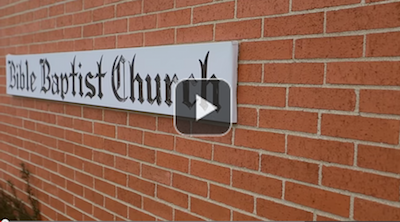FEBRUARY 26 / MARCH 5, 2017
THE THREEFOLD WITNESS OF JOHN THE BAPTIST
INTRODUCTION:
1. The great theme of the Gospel of John is “The Person of The Word made flesh.” This grand truth is the very foundation of John’s concept of regeneration or the new birth, through which faith comes, enabling a man born of flesh to become a child of God. This is possible because faith has as its object the Word who became flesh.
2. This coming of Christ in flesh was declared early on by John in the prologue to his Gospel. The Light which shineth in darkness speaks of the incarnation. (Verse 5) the incarnation was surely presented in relationship to the nation of Israel (Vs. 11); but he also plainly declared Christ coming in the flesh in relationship to the entire world of believers. (Vs. 14)
3. In our present study we will be considering the first manifestations of the Word made flesh. In this, we will see the opening of faith in the lives of the first apostles through the three testimonies of John the Baptist. John’s three testimonies were essentially these: He is here; there He is; follow Him. (Verses 26, 29, 36)
I. JOHN FIRST WITNESSED CHRIST AS PRESENT. (VERSES 19-28)
A. THIS WAS AN OFFICIAL ANNOUNCEMENT. (VERSE 19; CH. 5:33)
1. John was the heaven-sent official messenger who was to go before and announce the Messiah to the nation of Israel. His coming was predicted by the holy prophets. (Isa. 40:33ff; Mal. 3:1; 4:5) John was the harbinger for whom the nation was to be watching, one who would be easily identifiable. “Behold, I will send you Elijah the prophet,” which is to say, a prophet like unto Elijah, for he came “in the spirit and power of Elias.” (Luke 1:17)
2. This announcement was spoken in the presence of an official deputation sent to represent the Sanhedrin. The Sanhedrin was composed of seventy-one members, comprised of chief priests, elders of the people, and scribes. It made up the ruling body. Jesus was speaking of them when He said, “The scribes and Pharisees sit in Moses’ seat.” Moses hid himself established a tribunal of seventy-two elders, and it seems that such a body remained in the days of Joshua, and through the period of the kings. (Josh. 1:10; 23:2; 24:1, 31; II Chron. 19:8)
3. Here in the nineteenth verse we meet with the term “Jews” for the first time. While it is a designation of the people of Israel (Ch. 2:13; 3:1), but it oftentimes designates the nation as an unbelieving community, contrasted with the true people of God. (Rev. 3:9; Mark 7:3)
B. THIS ANNOUNCEMENT CAME IN RESPONSE TO AN INTERROGATION BY THE JEWISH DELEGATION. (VERSES 19c, 20)
1. The direct question reveals that there was an expectation of Messiah. “Who art thou?” Clearly, John’s ministry had aroused great curiosity and concern. (See Matt. 3:1-6)
2. John’s answers convey simplicity and humility. (Verse 20)
a) He confessed, and denied not. He being asked openly and plainly, professed, and did not try to conceal it. In Scripture negatives are sometimes added to affirmatives to exclude all exceptions. (See Job 5:17; Psa. 40:10-12) He confessed, and did not even begin to deny what was true.
b) He confessed, not once, but again and again, because many were musing about it. (Luke 3:15) This was his honest and official declaration.
c) “I am not the Christ.” He very firmly denied that he was that great Messiah which God had promised, and in the expectation of whom they lived. (Luke 2:25, 25; John 4:25)
C. JOHN’S ANSWER PROMPTED SOME FOLLOW-UP QUESTIONS BY THE DELEGATION. (VSES. 21-23)
1. They enquired, “Are thou Elias?” Are you Elijah, whom the prophet Malachi said would precede Christ? (Verse 21; Mal. 4:5)
2. They then asked, “Art thou that prophet?” Are you the prophet of whom Moses spoke? (Verse 21; Deut. 18:18)
3. John’s answer to both enquiries was that he was not. Since they meant the very persons, and not their spiritual personifications, John answered honestly.
a) John was a prophet like unto Elijah, not Elijah himself.
b) John was not “that prophet” of whom Moses spoke; that would be Christ Himself.
4. John, when pressed, responded by saying, “I am the voice of one crying in the wilderness.” (Verses 22, 23)
a) He was only a preparatory “voice.” (Isa. 40:3) See here the humility and self-abasement of this man. This was an essential part of his true greatness. (See Ch. 3:30; Matt. 11:11; Luke 7:28)
b) John owned that his role, as foretold by Isaiah, was to “make straight the way of the Lord.” As it was customary in the East to straighten and repair the roads for an approaching monarch, so John was preparing the way for Christ. This represented the spiritual condition of Israel at the time of His coming.
5. They particularly wanted to know about John’s baptism. (Verses 24, 25)
a) The majority of this delegation was of the sect of the Pharisees (Vse 24), the group most concerned about rites.
b) Since they understood him to deny being Messiah’s forerunner, why then did he baptize, since he seemed to lack authority to institute a new rite?
6. John gave them a most significant answer. (Verses 26, 27)
a) John defended his right to baptize by the fact that Messiah was present among them. (Verse 26)
b) The great shame was that they did not know Him.
c) John testified of Jesus’ absolute preeminence. (Verse 27)
7. John documents that this significant exchange took place “in Bethabara beyond Jordan where John was baptizing.”
8. This concludes the first of John’s three testimonies, which were given on three consecutive days. He first testified that “Christ was present.” He is here.
II. IN JOHN’S SECOND WITNESS HE POINTS OUT CHRIST ESSENTIALLY SAYING, THERE HE IS. (VERSES 19-28)
A. JOHN POINTED OUT CHRIST, AND, AT THE SAME TIME, INTRODUCED HIM AS GOD’S SACRIFICIAL LAMB. (VERSE 29)
1. This testimony was occasioned by Jesus coming to where John was. “John seeth Jesus coming unto him.”
a) Clearly this was not happenstance; the time had come for the “porter” to open to the true Messiah. (Ch. 10:3)
b) This was not the first time Jesus had come to where John was baptizing. He had come before to be baptized of him. (Matt. 3:13ff)
c) It was because of that previous meeting, when Jesus was baptized of him, that John could point to Him with absolute certainty and say “this is indeed the Christ.” (Compare Verses 31-34; Matt. 3:16, 17)
2. John pointed out Jesus by a certain designation, which declared his divine purpose in coming. “Behold the Lamb of God.”
a) He did not call Him The Christ, or the Son of God, or The King of Israel; but he called Him The Lamb.
b) He pointed to Him as God’s sacrificial Lamb, the Passover Lamb (our Passover – I Cor. 5:7); as the sin bearer of His people (Isa. 53:4-12). For this reason He took human flesh. (Heb. 10:5, 7)
c) Notice, He is God’s Lamb, of His provision, of His designation. (See Gen. 22:8, 13, 14)
3. John introduced Christ as He would expiate sin. “…which taketh away the sin of the world.”
a) This is to lift up and to carry off. This sets forth the complete expiation of sin.
b) The work is vast and extensive. “…the sin of the world.”
(1) It includes all men without distinction; Jew and Gentile.
(2) It includes every believer without exception.
B. JOHN POINTED TO CHRIST, THIS IDENTIFYING HIM AS THE ONE OF WHOM HE HAD BEFORE SPOKEN. (VERSE 30)
1. Here John explains the mystery which he spoke of on the day before. (Verse 15)
2. John refers to Jesus as “a man,” but one who was preferred before him, and indeed, before all men.
3. He was “a man,” and yet, before He was born, He already was. Though He was born after John, he was before him. Not only was He before John, but He would later declare, “Before Abraham was I am.” (John 8:58)
4. Clearly, Jesus was “a man,” but He was also eternal God. He was the God-Man and the Messiah.
C. JOHN NEXT RELATED HOW HE HAD ATTAINED THIS KNOWLEDGE OF HIM. (VERSES 31-33)
1. He disclaims any prior knowledge of Jesus, so how could he have such boldness to testify that this One was from eternity, and had now appeared in order to be the Redeemer, and to put away sin? (Verse 31)
a) John was in the wilderness until the time of his public ministry.
b) He states that his mission to baptize was expressly in order for him to know who Jesus was.
c) So it may not simply be that John didn’t’ know Him as Messiah before this, but possibly he didn’t know Him at all.
2. He was made aware of who Jesus was at His baptism. (Verses 32, 33)
a) This was manifested by the descent of the Spirit upon Him, and His abiding on Him.
b) John knew that this One could baptize, not merely with water, as himself, but with the Holy Ghost. (Verse 33)
c) Water baptism is very important, in that it is a symbol of Spirit baptism which is the reality.
d) When Jesus was baptized He was filled with the Holy Ghost without measure.
e) By the power of the Holy Spirit, and not by His innate deity, the Son of God would do all that He did.
D. JOHN THEN POINTED OUT THE IMPORTANCE OF THE ACT THAT HE HAD PERFORMED. (VS. 34)
1. John was satisfied that he had witnessed the truth. The facts recorded were established and would abide forever.
2. He bare record that this is the Son of God!
3. This concludes John’s second testimony. “There He is!”
III. JOHN’S THIRD WITNESS, WHICH OCCURRED THE NEXT DAY, WAS ESSENTIALLY, FOLLOW HIM. (VERSES 35-37) This witness resulted in the first disciples following Christ. We will consider these verses with our next study in which we will have The Calling of Christ’s First Disciples.



Speak Your Mind